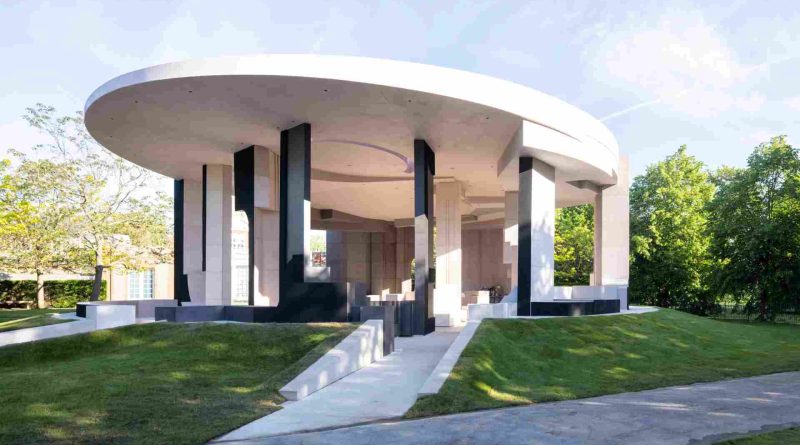Echoes of London’s Diversity: The Serpentine Pavilion and Its Migrant Inspirations
Imagine a collage of architectural remnants, where fluted classical columns intersect with steps, ledges, and curved moldings, forming an impromptu playground born from the depths of an architectural salvage yard. This captivating dreamland exudes faint echoes of familiar London landmarks, all harmonized in creamy hues of cement, unified beneath a colossal circular roof suspended six meters above.
Welcome to the new Serpentine Pavilion, a creation of Counterspace, an architectural practice hailing from Johannesburg and led by the talented 31-year-old Indian South African architect, Sumayya Vally. It seems apt that the youngest architect ever commissioned for this prestigious project has conceived one of the most expansive structures to date. Its grandeur extends not only in physical stature but also in its profound impact beyond the confines of Kensington Gardens: this year marks a departure with four additional structures dispersed throughout the city, accompanied by the launch of a fellowship program aimed at artists engaging with spatial politics and community practice.
Reflecting on her creation, Vally expresses, “I sought to mirror London back to itself.” Inside the pavilion, as the final pieces fall into place, she elaborates on her inspiration drawn from spaces significant to migrant communities across the city, ranging from cafes and libraries to hair salons and places of worship. Her ambition was to weave their memories into the fabric of the pavilion while extending its essence outwards, embracing the entirety of London.
The genesis of her design lies in a unique form of reverse archaeology. Vally meticulously sampled elements from over 50 sites across the capital, weaving them together through a process of layering, splicing, and subtracting. The resulting landscape resembles a fragmented tapestry of plinths and perches, reminiscent of the works of Rachel Whiteread or the theatrical sets of Adolphe Appia. Visitors are invited to traverse, rest, and immerse themselves in its intricacies, reminiscent of the excavated pavilion of 2012 by Herzog & de Meuron and Ai Weiwei, albeit with a deliberate emphasis on visibility, proudly standing as a monument to marginalized migrant communities.
Embraced by a verdant mound, the structure exudes an ancient, weathered charm, its exterior clad in dark cork, evoking a sense of gradual erosion over time. However, beneath this rugged facade lies a meticulously crafted framework of prefabricated plywood blocks covered in micro-cement render, supported by a recycled steel frame atop a robust concrete foundation. As with previous editions, the pavilion has already found a buyer, this time in the form of the Therme Group, an Austrian spa operator continuing the tradition of acquiring these architectural marvels.
The realization of this year’s commission was marked by a deeply immersive process. Vally’s relocation to London enabled her to delve into the city’s tapestry, exploring its radical archives and meandering through its streets, before the onset of the pandemic. Her fascination with London’s immigrant histories and community resilience, often entrenched in modest locales like cafes and bookshops, became a cornerstone of her vision.
References to these locales are abstracted within her pavilion design, offering subtle nods to places like Brixton’s domestic porches or the market stalls of Whitechapel. Each fragment holds a story, whether it’s the long bench inspired by an Iftar gathering outside the Al-Manaar mosque or the stage evoking memories of demolished music venues like the Four Aces in Dalston. Vally’s intent is not to dictate narratives but to evoke a collective sense of unity and belonging.
Beyond the pavilion’s physical presence lies a broader initiative comprising five equal pieces scattered across London, each tailored to serve its respective community. From a poetry-reading podium at New Beacon Books to an adaptable stage at the Albany arts center, each structure embodies functionality and inclusivity.
Despite the setbacks posed by the pandemic, the extended timeline allowed for the development of a comprehensive program, including Vally’s brainchild—the Support Structures for Support Structures fellowship. This groundbreaking initiative, born from her advocacy for vulnerable community arts spaces, aims to empower artists at the intersection of art, spatial politics, and community engagement.
However, amidst the acclaim lies a pertinent question regarding the pavilion’s sustainability. The substantial concrete foundation, required for its assembly, raises concerns about its environmental footprint and long-term impact. While the gallery defends its approach as a necessity to adhere to Royal Parks regulations and foster architectural innovation, questions linger about its ecological commitments and the embodied carbon of its annual installations.

